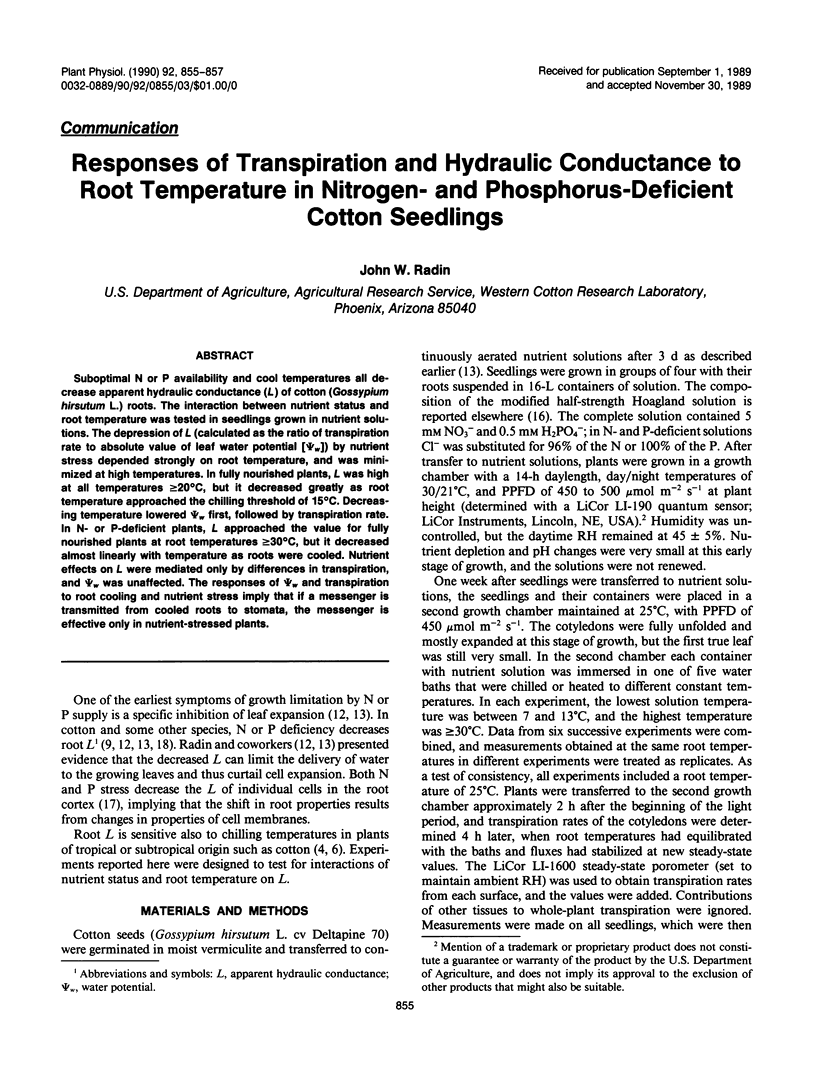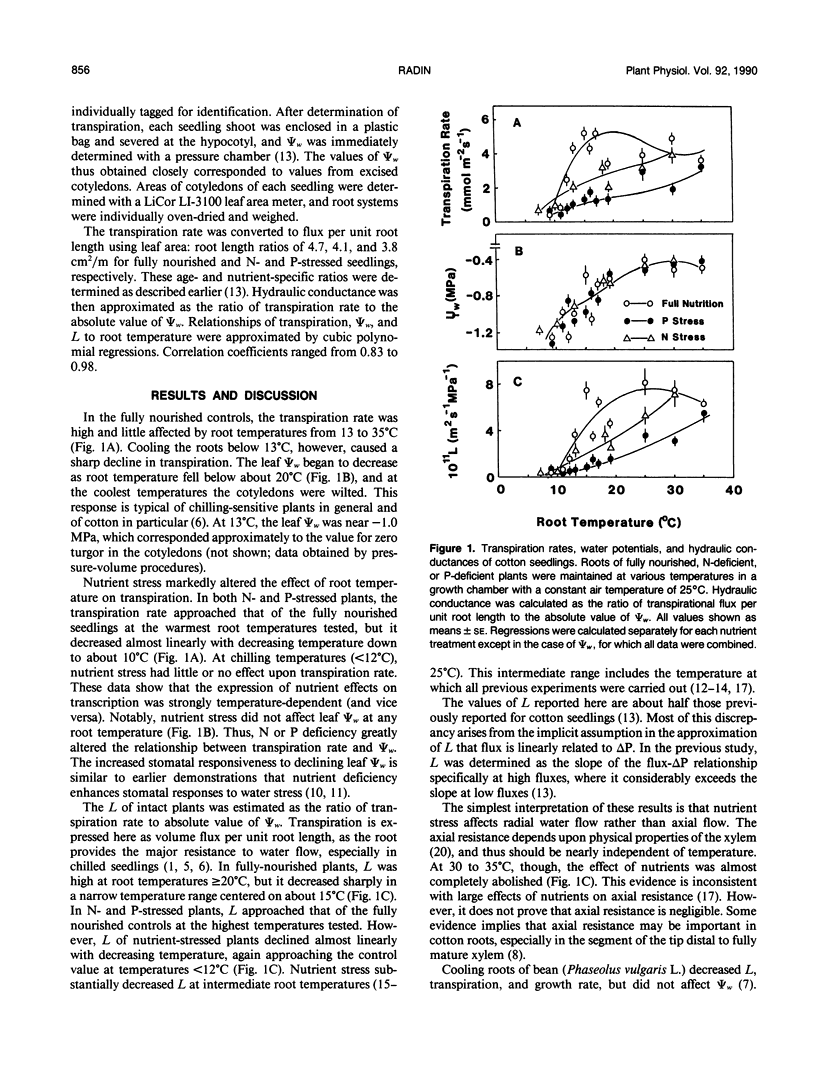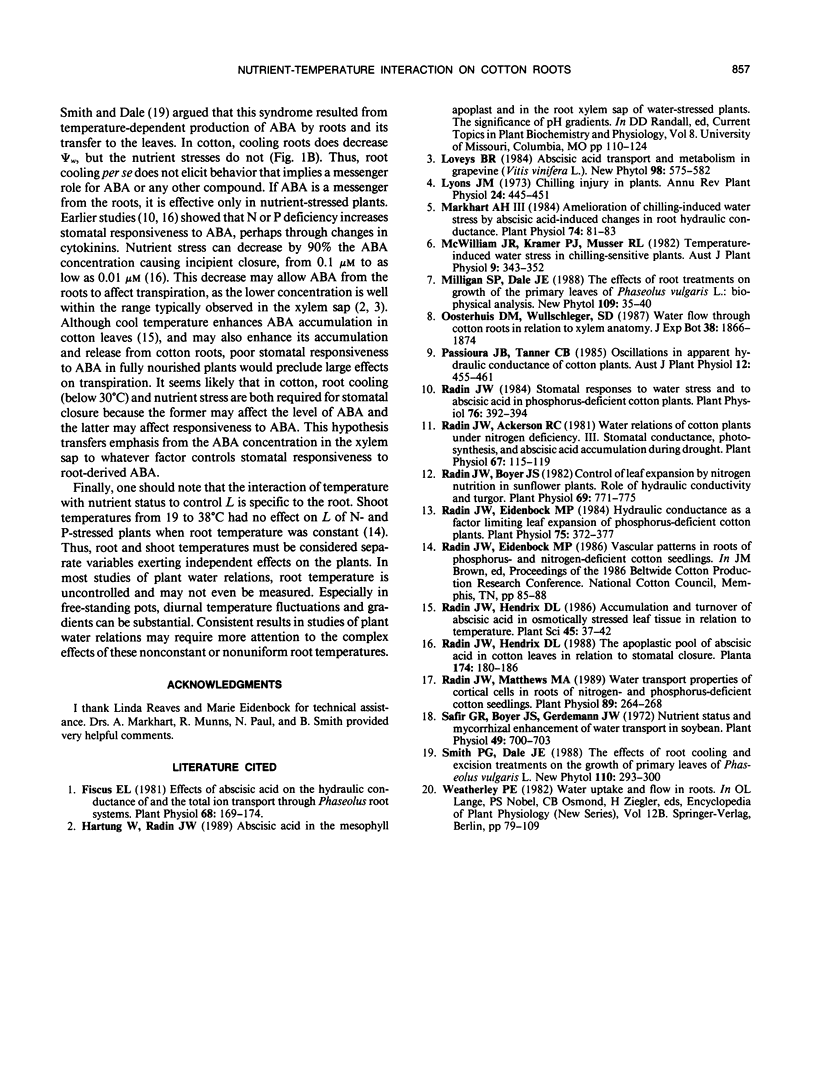Abstract
Suboptimal N or P availability and cool temperatures all decrease apparent hydraulic conductance (L) of cotton (Gossypium hirsutum L.) roots. The interaction between nutrient status and root temperature was tested in seedlings grown in nutrient solutions. The depression of L (calculated as the ratio of transpiration rate to absolute value of leaf water potential [Ψw]) by nutrient stress depended strongly on root temperature, and was minimized at high temperatures. In fully nourished plants, L was high at all temperatures ≥20°C, but it decreased greatly as root temperature approached the chilling threshold of 15°C. Decreasing temperature lowered Ψw first, followed by transpiration rate. In N- or P-deficient plants, L approached the value for fully nourished plants at root temperatures ≥30°C, but it decreased almost linearly with temperature as roots were cooled. Nutrient effects on L were mediated only by differences in transpiration, and Ψw was unaffected. The responses of Ψw and transpiration to root cooling and nutrient stress imply that if a messenger is transmitted from cooled roots to stomata, the messenger is effective only in nutrient-stressed plants.
Full text
PDF


Selected References
These references are in PubMed. This may not be the complete list of references from this article.
- Fiscus E. L. Effects of Abscisic Acid on the Hydraulic Conductance of and the Total Ion Transport through Phaseolus Root Systems. Plant Physiol. 1981 Jul;68(1):169–174. doi: 10.1104/pp.68.1.169. [DOI] [PMC free article] [PubMed] [Google Scholar]
- Markhart A. H. Amelioration of chilling-induced water stress by abscisic Acid-induced changes in root hydraulic conductance. Plant Physiol. 1984 Jan;74(1):81–83. doi: 10.1104/pp.74.1.81. [DOI] [PMC free article] [PubMed] [Google Scholar]
- Radin J. W., Boyer J. S. Control of Leaf Expansion by Nitrogen Nutrition in Sunflower Plants : ROLE OF HYDRAULIC CONDUCTIVITY AND TURGOR. Plant Physiol. 1982 Apr;69(4):771–775. doi: 10.1104/pp.69.4.771. [DOI] [PMC free article] [PubMed] [Google Scholar]
- Radin J. W., Eidenbock M. P. Hydraulic conductance as a factor limiting leaf expansion of phosphorus-deficient cotton plants. Plant Physiol. 1984 Jun;75(2):372–377. doi: 10.1104/pp.75.2.372. [DOI] [PMC free article] [PubMed] [Google Scholar]
- Radin J. W., Matthews M. A. Water transport properties of cortical cells in roots of nitrogen- and phosphorus-deficient cotton seedlings. Plant Physiol. 1989 Jan;89(1):264–268. doi: 10.1104/pp.89.1.264. [DOI] [PMC free article] [PubMed] [Google Scholar]
- Radin J. W. Stomatal responses to water stress and to abscisic Acid in phosphorus-deficient cotton plants. Plant Physiol. 1984 Oct;76(2):392–394. doi: 10.1104/pp.76.2.392. [DOI] [PMC free article] [PubMed] [Google Scholar]
- Radin J. W. Water Relations of Cotton Plants under Nitrogen Deficiency: III. STOMATAL CONDUCTANCE, PHOTOSYNTHESIS, AND ABSCISIC ACID ACCUMULATION DURING DROUGHT. Plant Physiol. 1981 Jan;67(1):115–119. doi: 10.1104/pp.67.1.115. [DOI] [PMC free article] [PubMed] [Google Scholar]
- Safir G. R., Boyer J. S., Gerdemann J. W. Nutrient status and mycorrhizal enhancement of water transport in soybean. Plant Physiol. 1972 May;49(5):700–703. doi: 10.1104/pp.49.5.700. [DOI] [PMC free article] [PubMed] [Google Scholar]


